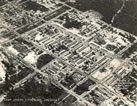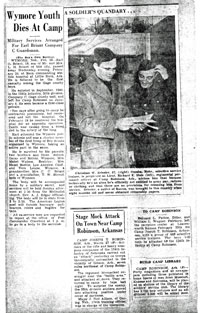 |
134th Infantry Regiment"All Hell Can't Stop Us" |
 |
 |
134th Infantry Regiment"All Hell Can't Stop Us" |
 |
"The Regiment assembled early in January, 1941, at Camp Joseph T. Robinson, near Little Rock, Arkansas, as a part of the 35th Division. Colonel Clyde McCormick, of Omaha, Nebraska was in command of the Regiment, until early May, when Colonel Butler B. Miltonberger, then commanding the First Battalion, assumed command. In August the Regiment participated in the largest scale maneuvers ever held in the United States, 'fighting' across southern Arkansas and northern Louisiana. Arriving back at Little Rock, after having distinguished itself in this training test, the Regiment was officially adopted as native sons of Arkansas by the Governor on behalf of the citizens of the state."
Prepared by the I & E Section, 134th Infantry
Photographs are from the book entitled "35th Division - Camp Robinson, Arkansas" printed by the Arkansas Printing and Lithograph Company, Little Rock, Arkansas, 1941.
Thanks to Mr. Eric Elliott for submitting the pictures above. Eric Elliott is the grandson of T/Sgt. Bernard A. Elliott, Comapny D, 134th Infantry Regiment
 |
Aerial view of Camp Robinson - 1941 |
Thanks to Ms. Nancy Woodside for submitting the picture above. Nancy Woodside is the daughter of Cpl. Lorens Woodside, 448th Antiaircraft Artillery Automatic Weapons Division
 |
Beatrice Sun (Nebraska) Newspaper Article 1941 |
Thanks to Lynn Lampe Salsbury, daughter of S/Sgt Alvin L. Lampe for this newspaper article from her father's collection.
"It was hardly more than two weeks after the President's call for mobilization that the 134th Infantry closed in at Camp Joseph T. Robinson, Arkansas, on January 8, 1941. The newly-constructed camp was not yet finished to the satisfaction of its newly-arrived occupants, however, and the first days were taken up largely in building walks, in developing facilities which would make the stay - it looked like it would be a long one - more comfortable, in introducing measures of traditional Army "eye-wash." Then came the weeks of training. It was progressive training, which began with several weeks of basic training of the individual soldier - military courtesy and discipline, first aid and hygiene, physical training, Articles of War, weapons. There were squad problems and combat field firing - with such weapons as the 60mm mortar and the light machine guns usually simulated. Rapid-fire exercises involved some time and effort at mastering the bolt manipulation of the Springfield rifle. Then followed platoon and company problems with blackout conditions prevailing. Finally there were regimental problems - some of the most interesting being against and "enemy" made up of the 137th Infantry, sister regiment to the 134th in Colonel Per Ramee's 69th Brigade. Colonel Miltonberger became regimental commander on 6 May. But this was only the beginning. More serious tests of ingenuity and physical endurance lay ahead - in the direction of Louisiana.
During the weeks at Camp Robinson, the 134th Infantry had been finding its place as a part of the team of Major General Ralph E. Truman's 35th ("Santa Fe") Division. Organized then as a "square" division, the Santa Fe - made up of National Guardsmen of Kansas, Nebraska, and Missouri, - included four infantry regiments, the 134th, 137th, 138th and 140th. On their shoulders, men of the 134th wore the blue and white Santa Fe insignia. The division insignia represented a white Santa Fe cross upon a wagon wheel with four quadrant projections, the whole on a blue field. The cross was taken from the crosses used to mark the Santa Fe Trail on dusty plains in the West. The men who wore it carried a symbol of the courage, hardiness, self-reliance, and pioneering spirit which characterized their forbears who opened up the lands west of the Mississippi.
With the other units of the 35th Division, the 134th Infantry moved in August to the vicinity of Prescott, Arkansas, to join the concentration of Lt. Gen. Ben Lear's Second Army. It was preliminary to participation in the biggest peace-time maneuvers scheduled in the country. The very evening of arrival, an 11-piece band, made up of musicians from the Regimental Band, played for a downtown street dance in Prescott given in honor of the 134th Infantry. Twenty men from each company of the Regiment rode the motor convoy into town for the affair, and Miss Verna Marie Porter, Chamber of Commerce representative in charge of arrangements - particularly of arrangements for a corps of southern belles to be on hand - became first of "Sweethearts of the 134th."
There were a few days for adjusting mosquito nets, shelter tents, and hammocks, and for reconnoitering the dense timberland - and of course, for additional company and regimental training - prior to the opening of the official exercises on Monday, August 18. There was particular interest during this preliminary training - and marksmanship was a favored and well-developed subject with Colonel Per Ramee - in becoming aquatinted with the new Garand M-1 rifle, the semi-automatic successor to the old Springfield which had replaced the bolt-operated weapon in the regiment just prior to the departure to Camp Robinson.
Maneuvers extended through the "Corps Phase," "Army Phase," and "GHQ," in which the headquarters concerned directed the exercises, but it made little difference to a regiment and its individual soldiers whether they were participating in division or corps or army exercises. The marches were as difficult, the mosquitoes as persistent, the chiggers as itch-worthy , the darkness as complete. A squad's problems or a company's frontage did not vary necessarily with the number of such units involved.
In the "Corps Phase," the 35th Division was joined with the 27th and 33rd Divisions in the VII Corps, under command of Maj. Gen. Robert C. Richardson, Jr., whose chief of staff was Col. J. Lawton Collins. After eight days of make-believe war between the "states" of "Almat" and "Kotmk," this phase came to a close with a final success of the 134th Infantry at the end of a 60-mile night move of the 69th Brigade. A Second Army press release noted:
The last problem in the "Corps Phase" of the Arkansas-Louisiana maneuvers came to a close at 8:00 A. M. Thursday after the invading Kotmk forces had accomplished their mission, that of destroying the Missouri-Pacific Railroad between Camden and the Little Missouri River. The unit that did the job was the 134th Infantry, composed entirely of Nebraskans and led by Lieut. Col. Butler B. Miltonberger, of North Platte, Nebr.
In these and succeeding exercises the men of the 134th learned to apply field expedients and to improvise in every kind of situation. Supply personnel encountered the difficulties of moving up chow in blackout - of difficult roads and tactical conditions, of timing to get supper up after darkness and breakfast, and prepared dinners, before daylight. Men learned to maintain contact at night through the dark timberland by forming columns of files in which each man grasped the belt of the man ahead. There were the skirmishes and rapid movements and night withdrawals which became a part of training and a parcel of memory. There were the rapid thrusts of the supporting dust-swirling tanks of Maj. Gen. George S. Patton JR's 2nd Armored Division; the 2nd Cavalry Division's crossing of the Ouachita River two days sooner than the Second Army staff thought possible, and its attack straight into the 134th Infantry; rest days and the quest for relief from the sultry heat of summer in the South in the old swimming holes.
In the main event, the operations in which General Lear's Second Army of 130,000 men faced Lt. Gen. Walter Krueger's Third Army of 330,000 men, it was more of the same for the 134th Infantry. But the men had something to look forward to on completion of maneuvers when they heard that members of the 35th Division had been adopted as "foster sons of Arkansas" in a proclamation by Governor Homer M. Adkins, and a big "Military Mardi Gras" was being planned to welcome them back to Little Rock."
134th Infantry Regiment Combat History of WWII - Major General Butler B. Miltonberger and Major James A. Huston